Dito Sama 603795 Handleiding
Dito Sama
Staafmixer
603795
Bekijk gratis de handleiding van Dito Sama 603795 (6 pagina’s), behorend tot de categorie Staafmixer. Deze gids werd als nuttig beoordeeld door 2 mensen en kreeg gemiddeld 4.8 sterren uit 1.5 reviews. Heb je een vraag over Dito Sama 603795 of wil je andere gebruikers van dit product iets vragen? Stel een vraag
Pagina 1/6

TBM150 GB 02 2014
1
GB
09/2021
Please refer to the numbered drawings
which correspond to the paragraph numbers of the instruction manual.
Contents
Introduction 1
Installation 1
Use, safety 3
Cleaning, hygiene and storage 4
Fault finding 4
Maintenance 5
Conformity with regulations 6
Introduction
1. DESCRIPTION1
• This turbo liquidiser is used to mix, liquidise, reduce and
emulsify vegetable and fish soups, fruit and vegetable purées,
liquid pastries and sauces, etc. directly in cooking containers.
It is mainly used in large catering and central kitchens and the
food preparation industries. Please ask for details on other ap-
plications.
A Trolley
B Handle
C Motor housing with
handles
D Body
E Hinge sleeve
F Body locking pin
G Rotating body locking knob
H Immersion tube
I Height adjustment handle
J Liquidising head
K Protection ring
L Stand
M Castors
Installation
2. DIMENSIONS - WEIGHT (for information only)1
- Gross weight when packaged : 220 kg
- Net weight equipped : 170 kg
- Dimensions of packaging L x l x H : 1780 x 840 x 1400 mm
- Machine dimensions: 1852 x 663 x 1475 mm
Handling – Transport
- The Turbo-Liquidizer is delivered on a wooden pallet.
- Use a forklift truck to remove it from the pallet, slipping the
forks beneath the trolley.
1.1
2.1
Introduction
The User Manual contains useful information for the user on
how to work correctly and in complete safety, and is designed
to make it easier to use the machine (called «machine» or
«appliance» below).
What follows is in no case intended to be a long list of warnings
and constraints, but rather a series of instructions meant to
improve the service provided by the machine in every respect,
and particularly to avoid a series of injuries or damage to equi-
pment that might result from inappropriate procedures for use
and management.
It is essential that all the people responsible for transporting,
installing, commissioning, using, maintaining, repairing or dismant-
ling the machine should consult this manual and read it carefully
before proceeding with the various operations, in order to avoid
any incorrect or inappropriate handling that might be result in
damage to the machine or put people’s safety at risk.
It is just as important that the Manual should always be available
to the operator and it should be kept carefully where the machine
is used ready for easy and immediate consultation in case of any
doubt, or in any case, whenever the need arises.
If after reading the Manual, there are still any doubts concerning
how to use the machine, please do not hesitate to contact the
Manufacturer or approved After Sales Service provider, who
is constantly available to ensure quick and careful service for
improved machine operation and optimum efficiency.
Note that the safety, hygiene and environmental protection stan-
dards currently applicable in the country where the machine is
installed must always be applied during all phases of machine
operation. Consequently it is the user’s responsibility to ensure
that the machine is operated and used solely under the optimum
safety conditions laid down for people, animals and property.
ATTENTION!!
Machine storage: -25°C to +50°C
Ambient temperature during operation: +4°C to +40°C
This machine is for professional use and must be used by staff trained to use, clean and maintain it, in terms or reliability and
safety.
Use the machine in adequately lit premises (See applicable technical standard for the country of use. In Europe, refer to standard
EN 12464-1)
When handling the machine, always check that the parts taken hold of are not mobile elements: risk of dropping and injury to the
lower limbs.
The machine is not designed for use in explosive atmospheres.
If unloaded manually, take all necessary precautions to ensure
the appliance does not tip at all
The reference language for these instructions is French.

•
Check that the voltage of the electrical system is the same
as that marked on the rating plate and the label on the power
cable.
•
The machine must be protected by a differential circuit breaker
and a fuse per phase of the rating shown in column of the H
characteristics.
•
: Electrical characteristics
B Number of phases (3 three phase)
C Nominal voltage in Volts (value, range or commutation)
D Frequency (Hertz)
E Motor speed (rpm)
F Nominal power (Watts)
G Nominal current (Amperes) depending on the voltage
H Rating of fuse protecting electrical line (Amperes)
I Approximate electrical consumption (Kwh)
•
Types of motor:
a) 230/400 V three phase motor - single speed:
- Provide a single phase wall socket with 3 phases + earth,
rating 20A and a matching watertight plug fitted on the power
supply cable.
2.2a
•
Check the direction of rotation of the rotor: by means of the
arrow marked on the top of the liquidising head (anticlockwise
direction )
- If the direction of rotation is reversed, change over the two
phase wires on the plug.
2. ELECTRICAL CONNECTION2
ATTENTION!!
Connection to the electrical power supply must be done according to proper professional practice by a qualified and authorised
person (see current standards and legislation in the country of installation).
If an adapter is used on the socket, a check must be made that the electrical characteristics of this adapter are not lower than
those of the machine.
Do not use multiple plugs
The AC power supply to the machine must comply with the following conditions;
- Maximum voltage variation: ±5%
- Maximum frequency variation: ±1% on a continuous basis, ± 2% over short periods
ATTENTION: the electrical installation must comply (for design, creation and maintenance) with the legal and standard
requirements in the country where used.
- Check that the electric mains voltage, the value shown on the specification plate.
- The machine’s electrical power supply must be protected against voltage surges (short-circuits and excess voltages) by using
fuses or thermal relays of the appropriate gauge relative to the place of installation and machine specifications – see the spe-
cifications shown in column H of figure 2.2a
ATTENTION: Concerning protection against indirect contact (depending on the type of power supply provided and
connection of the exposed conductive parts to the equipotential protection circuit), refer to point 6.3.3 of EN 60204-1 (IEC
60204-1) with the use of protection devices for automatic shut-off of power in the event of an insulation fault with a TN or
TT, system, or for the IT system, with the use of a permanent insulation or differentials controller for automatic shut-off.
The requirements of IEC 60364-4-41, 413.1 must apply for this protection.
For example: in a TT system, a differential circuit breaker must be installed upline of the power supply, with a suitable
power cut-off (e.g.: 30 mA) on the earthing installation for the place where it is planned to install the machine.
ATTENTION: Failure to comply with these instructions means the customer runs the risk of machine failure and/or acci-
dents due to direct or indirect contacts.
The machine must be earthed with a green / yellow wire.
b) Three phase motor - single voltage - 400 V or 230 V - 2 speed:.
- Cannot be switched over.
The machine must be earthed with a green / yellow wire.
To PAT test the Electrolux Range of Food Preparation Equipment,
the PCB board needs to be disconnected before any test is done.
This is due to the fact that the boards are fitted with a grounding
diode that can give incorrect result during such a test. Also on a
standard appliance a flash test of 25 amps and up to 3000v is
used but, as you would expect, to use this on equipment, which
has a printed circuit, board would be quite destructive to that
board. We would recommend the use of a PAT tester approved
for computer systems which use a lower rate of amps.
The appliance is perfectly safe and is CE certificated. There are
two ways to get overcome this problem.
· Disconnect the board as instructed and test using test for
PC’s,
· Or install the mixer on a fused spur (no plug) as this takes it
away from being a portable appliance and the PAT test is then
not needed.
TBM150 GB 09 2021
2
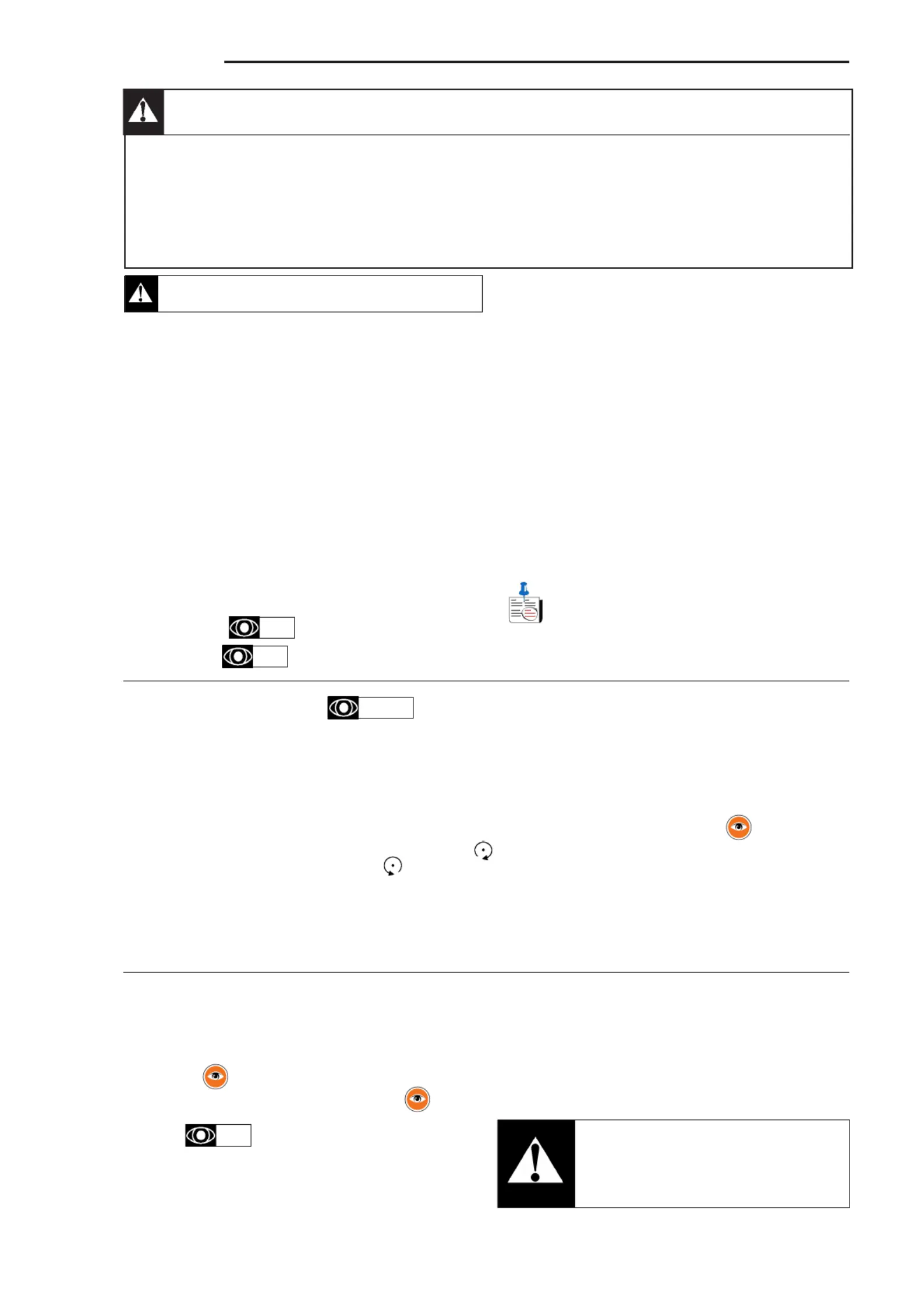
Use, safety
3. OPERATION, SAFETY1
•
The safety of the user is ensured by:
- The motor stopping and jog operation when the body is
angled.
- The motor is stopped and started in pulse mode when the
body is slanted. The working area lies between 300mm and
900mm relative to the floor.
- The START button needing to be pressed after stoppage ("no
voltage" release).
- The motor being protected against voltage surges by means
of a thermal relay.
- Respecting the instructions of this manual for the use, cleaning
and maintenance of the machine.
•
Electrical control housing, depending on models:
1) Single speed
2) Two speed
A START push button (black)
B STOP push button (red)
C Lifting handles
D Mains switch
E Low speed V1 push button
F High speed V2 push button
•
The turbo-liquidiser operates continuously if the body is
horizontal, held by the pin and the mains switch is in the START D
position.
a) Continuous operation:
- Press the black button , then the low speed or high speed A E
F buttons (two speed model).
b) Jog operation (body angled):
- Simultaneously press the black button and either the or A E
the button (two speed model).F
Note: The turbo-liquidiser only operates continuously if
the user presses the START and buttons at the A E, F
same time (two speed model).
c) Stopping:
- Press the red button .B
3. DIFFERENT POSITIONS2
• This turbo-liquidiser has two stable positions (attached by
the pin F), as the intermediate positions are unstable:
a) Stable position, body horizontal, continuous OPERA-
TION:
- Adjustable height (1), approximately 175 mm, to adapt to diffe-
rent types of recipients. The protective ring on the liquidising
head must operate at a distance of between 50 mm and 150
mm from the bottom. Turn the handle I in a clockwise direction
to raise it and in an anti-clockwise direction to lower it.
- Horizontal movement (2), lock in position using the knob .G
b) Stable position, body angled for storage:
- Remove the pin .F
- Pull the body towards the handles.
3.1a
3.1b
3.2a-b-c
- Raise the body and insert the pin through the body to position 3.F
c) Unstable positions, body angled, without the pin F, jog
OPERATION.
- Operator moves the liquidising head in a sweeping movement
in the recipient in order to obtain a consistent mixture.
- Setting the intermediate position (see § 3.2 a).
Remarks:
- In the work position, immobilise the turbo liquidiser by locking
the two rear castors.
- Use a container which is suitable for the product and quantity
to be processed so that the head is completely immersed.
Clean the machine properly prior to its first use
Never put a hand in the ejection area while the machine is in operation; risk of injury. It is strictly forbidden to put the safety systems
out of action or modify them: Risk of permanent injury!!!!
Check that the safety devices operate correctly each time before using (see paragraph on «safety system adjustments»). Never
put a hand, a hard or frozen object in the appliance
For health and safety reasons, always use a washable or disposable strong head covering that covers the hair completely.
ATTENTION!!
- Unscrew the captive wing nut as far as possible.A
- Place the drive hub on the hexagonal shaft of the machine B
rotor then turn it until the 3 lugs are seated in the cavities in C
the liquidising head.
- Tighten the wing nut firmly.A
- Do not operate the micro liquidiser if its head is not
immersed.
- Only use the micro liquidiser at low speed (2 speed
model).
- The micro liquidiser must be removed after use.
3. MICRO LIQUIDISER OPTION 3
•
Two micro liquidisers are used at the end of the preparation
cycle and are attached separately to the liquidising head.
1) The "kitchen" micro liquidiser for fine liquidising of stringy
products (see §3.4.2).
2) The special "fish soup" micro liquidiser (see §3.4.3).
•
Fitting:
- Stop and place the turbo-liquidiser in a stable position (see
§ 3.2b).
- Unplug the machine.
3.3
TBM150 GB 01 2014
3
Any other use than that described in this manual will not be
considered normal by the manufacturer.
Product specificaties
| Merk: | Dito Sama |
| Categorie: | Staafmixer |
| Model: | 603795 |
Heb je hulp nodig?
Als je hulp nodig hebt met Dito Sama 603795 stel dan hieronder een vraag en andere gebruikers zullen je antwoorden
Handleiding Staafmixer Dito Sama
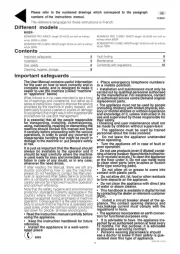
11 Augustus 2025
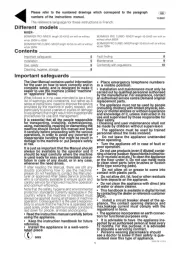
11 Augustus 2025
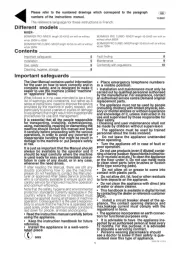
11 Augustus 2025
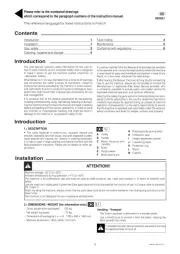
11 Augustus 2025
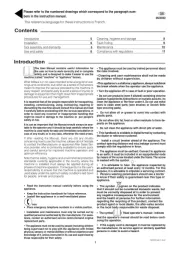
11 Augustus 2025
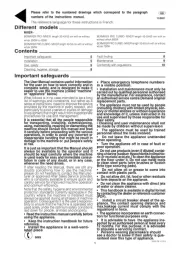
11 Augustus 2025
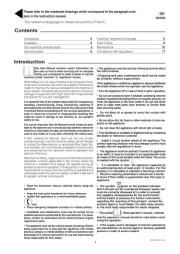
11 Augustus 2025
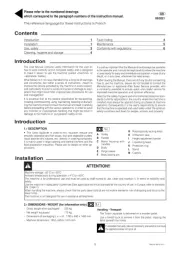
11 Augustus 2025
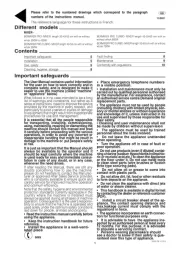
11 Augustus 2025
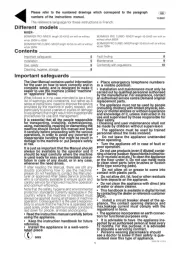
11 Augustus 2025
Handleiding Staafmixer
- Orbegozo
- Hotpoint
- Gastronoma
- Ideeo
- Soundcraft
- Graef
- KitchenAid
- Petra Electric
- Emerio
- Maestro
- Nordmende
- Hyundai
- Sinbo
- Brentwood
- Bifinett
Nieuwste handleidingen voor Staafmixer
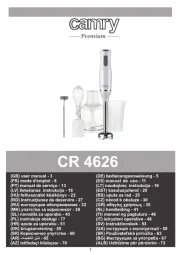
11 Augustus 2025
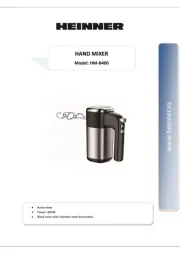
11 Augustus 2025
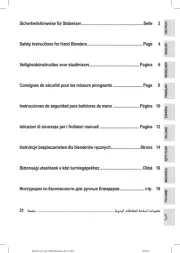
11 Augustus 2025
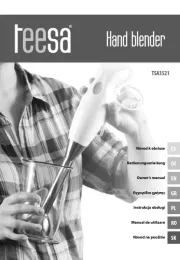
5 Augustus 2025

4 Augustus 2025

4 Augustus 2025
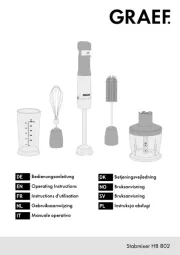
3 Augustus 2025
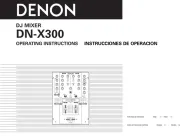
30 Juli 2025
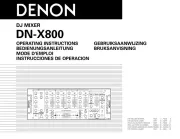
30 Juli 2025
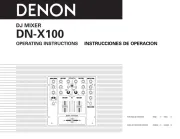
30 Juli 2025